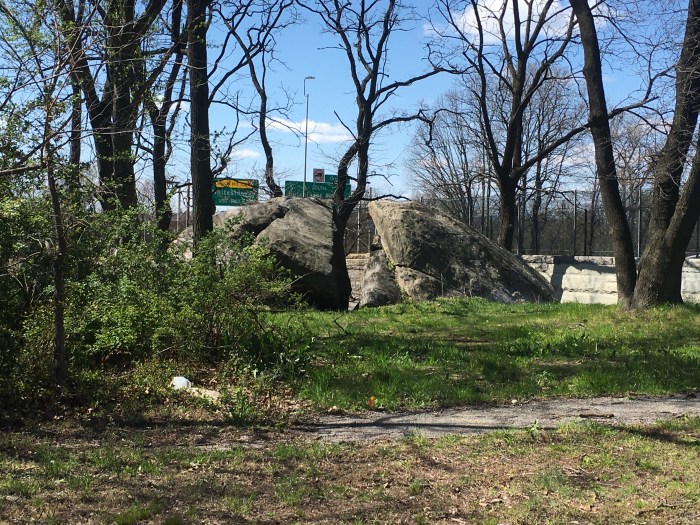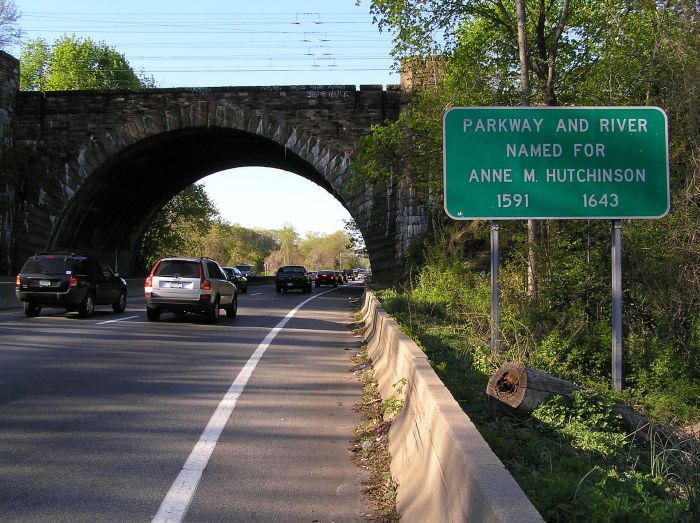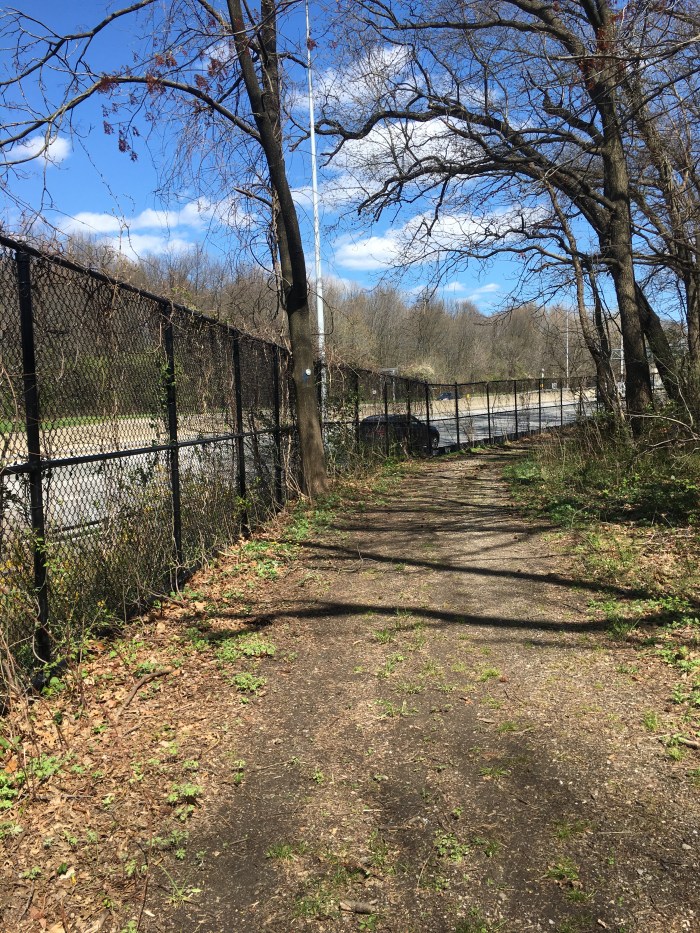
This site has been on my bucket list ever since I first learned about it. It is neither in Ossining, nor something I’ve run by, but it is certainly history I’ve passed by . . .
In Pelham Bay Park there sits an enormous boulder split in two. It’s located on a tiny spit of land between the Hutchinson River Parkway and the exit to I-95N – you can see it from the Hutch briefly as you drive by if it’s winter, you’re in the passenger seat, and know exactly where to look.
The text below is apparently on an historical marker posted within Pelham Bay Park. I did not see it, but I would have read it if I had. Luckily, the NYC Parks Department has helpfully posted it on their website. So let’s start there:
Split Rock is a glacial boulder, divided in half with a large crevice between the two pieces, and is an important part of the history of Pelham Bay Park and the Bronx. It was in this gap that Anne Hutchinson and her daughter, Susannah, supposedly hid during the attack of the Siwanoy Native American tribe in 1643. Although the Siwanoy killed Hutchinson, it is believed that the Siwanoy protected and raised Susannah.
Split Rock Road was also the site of the Battle of Pell’s Point where, on October 18, 1776, Colonel John Glover (1732-1787) successfully safeguarded General George Washington’s (1732-1799) retreat to White Plains with a small band of Patriots against a large British and Hessian force. Glover placed his four regiments behind the stone walls along the side of the road to surprise the British and Hessian troops. Pieces of the walls can still be seen near the Split Rock.
Split Rock is located near the 375-acre Thomas Pell Wildlife Sanctuary, which was designated on October 11, 1967, to preserve the natural wetlands of Pelham Bay Park. The Sanctuary and marsh are situated along the western boundary of Pelham Bay Park at the Hutchinson River, and holds both salt marsh and forested lands. Salt marshes, characterized by saltmarsh cordgrass (Spartina alterniflora), are among New York’s least known and most valuable natural resources. Salt marshes flourish behind barriers of beach and sand, in the shelter of coves, lagoons, and bays, and along the banks of estuaries. They reduce erosion, and they provide for rich wildlife habitats.
The area is home to a variety of wildlife including raccoon, egrets, hawks, ibis, and, coyote. The border between salt marsh and forest is a good place to see yellow thistle (Cirsium horridulum) and holy grass (Hierchloë odorata), both rare in the City. The Sanctuary is named for Thomas Pell, the first European to control the land.
There is a Split Rock Trail that meanders 1.5 miles from the Bartow traffic circle through the Goose Creek Marsh, and the Thomas Pell Wildlife Sanctuary, to Split Rock. The trail runs near the former Split Rock Road, which now winds through the Split Rock Golf Course. The road was a former Siwanoy Trail between City Island and Pelham. In the summer of 1987 Parks and the Mayor’s City Volunteer Corps worked together to restore the Split Rock Trail for the public. The rock sits in the northwest corner of Pelham Bay Park at the junction of the Hutchinson River Parkway and the New England Thruway.[1]
A glacial boulder, massacre, a Native American trail, a Revolutionary War battle, rare thistle and salt grass? This site has thousands of years of history on it.
But let’s back up first, though, shall we? You must know of the Hutch, that narrow, windy Parkway that starts at the Bruckner and goes up about 20 miles to the Connecticut state line. If anyone still listens to traffic reports on the radio, the Hutch is almost always backed up with a disabled vehicle, a tractor trailer that has fallen from I-95 stopping traffic, etc. I hate driving it, although I love the name of it because it is one of the only (possibly THE only) New York State highways named after a woman.

The Parkway is named after the Hutchinson River it parallels, which in turn is named after Anne Hutchinson, the Puritan intellectual, activist and rebel. She was probably one of the most infamous women in her time, due not only to her unorthodox interpretation of the bible, but also her audacity of speaking and teaching these ideas in public. Throw in a hefty dose of patriarchal disapproval, fear and disdain for women, and you have the recipe for banishment.

Born Anne Marbury in 1591 in Lincolnshire, England, she was fairly well-educated for a young lady of her time. (Also, just parenthetically, she was born the year that Shakespeare wrote “The Taming of the Shrew”, “Henry VI” pts. 1,2 &3, and “Titus Andronicus.” This is in no way relevant, it is just some context that I find interesting.) Anne married William Hutchinson, a merchant, and they went on to have 14 or 15 children together. They also were extremely serious about their beliefs, and in 1634 followed the preacher John Cotton to Boston, Massachusetts on the HMS Griffin.
It was in Boston that Anne got into trouble for questioning the teachings of many Puritan ministers, accusing them, in effect, of not being pure enough, as they stressed the Covenant of Works over the Covenant of Grace. Without getting too deep into the weeds of Puritan theology, let’s just say this is called the Antinomian Controversy, and ended up with Anne being put on trial in 1637 for 80 or so counts of heresy of which, surprise, she was convicted and banished from the Massachusetts Bay Colony. Banishment was probably the kindest punishment for the time, considering that in England, heretics were often burned at the stake or hanged. Also, Anne might have been pregnant at the time, so perhaps the overlords were being merciful . . .
(It’s funny, isn’t it, how a group of people who emigrated from England on the grounds that they weren’t able to practice their religion freely, refused to allow others to practice THEIR religions freely in the New World. Ah, the base hypocrisy upon which our nation was founded!)
Anne, her husband and children left Massachusetts, along with Roger Williams and some other purists, to settle in Portsmouth, later Rhode Island. But just a couple of years later, again under threat from the long arm of Massachusetts, she and her husband took their six youngest children down to the wilds of New Netherlands, purchasing a tract of land in what is now the Bronx. In a tragic example of the cliché “out of the frying pan and into the fire,” the land they purchased from the Dutch belonged to the Siwanoy tribe, who did not recognize (or possibly even know about) the European transaction.
Tensions were high before the Hutchinson clan even arrived, due to the ongoing Kieft’s War, which was waged by the New Netherlanders against the Lenape, resulting in the massacre of many Native Americans. The other local tribes were united by these atrocities, and sent many warnings to Anne. Her husband William had died soon after they arrived, and Anne was left to build a house and set up a farm.
She had had convivial relationships with the Native Americans in Massachusetts and Rhode Island, so she apparently was not afraid or concerned when they visited her Pelham property on several occasions. For example, they would gather up the tools of her carpenter, James Sands, as he worked to build her house, and gesture to him to leave. (After a few days of this, he finally did, and she just engaged a different carpenter to finish the job.)
But the Siwanoy were not to be ignored.
Eve LaPlante, who wrote American Jezebel, the Uncommon Life of Anne Hutchinson, the Woman who Defied the Puritans, described the fateful day as follows:
The Siwanoy warriors stampeded into the tiny settlement above Pelham Bay, prepared to burn down every house. The Siwanoy chief, Wampage, who had sent a warning, expected to find no settlers present. But at one house the men in animal skins encountered several children, young men and women, and a woman past middle age. One Siwanoy indicated that the Hutchinsons should restrain the family’s dogs. Without apparent fear, one of the family tied up the dogs. As quickly as possible, the Siwanoy seized and scalped Francis Hutchinson, William Collins, several servants, the two Annes (mother and daughter), and the younger children—William, Katherine, Mary, and Zuriel. As the story was later recounted in Boston, one of the Hutchinsons’ daughters, “seeking to escape,” was caught “as she was getting over a hedge, and they drew her back again by the hair of the head to the stump of a tree, and there cut off her head with a hatchet.

Depiction of the massacre of Anne Hutchinson and her family, found in William Cullen Bryant’s “A popular history of the United States,” 1878 (PUBLIC DOMAIN)
Afterwards, all was burned to the ground and this is partially why no one has ever been able to find the exact place where the Hutchinson farm stood.
It is here that the Split Rock takes centerstage. As the massacre was happening, nine-year-old Susanna was, so legend has it, picking blueberries some distance away. When she heard the screams, she hid in the split of the rock. But the Siwanoy found her and took her captive (some theorize they did this rather than kill her because she had red hair, which they had never seen before.) She apparently lived with them for several years before she was ransomed back to family in Massachusetts, where she went on to marry and have 11 children. Author Katherine Kirkpatrick wrote a necessarily fictionalized YA novel called Trouble’s Daughter: The Story of Susanna Hutchinson, Indian Captive, that imagines this part of Susanna’s life.
If you’ve made this this far, you definitely want to know how to get to the Split Rock. Now, I will tell you, but note that to get right up close to it, you have to run across the entrance ramp to I-95, something I absolutely and categorically do not recommend you ever do. But here are directions on how to get close enough to see it clearly – FYI this hike takes about 20 minutes each way:
Go to the very end of Beech Tree Lane, in Pelham. (GoogleMaps will get you right there.)
At the end of the street is a pathway that enters onto the Bridle Path in Pelham Bay Park – it’s fairly clearly marked. Pass through the low wooden gate and you will see the Pelham Bay Golf Course in front of you. Take a right, and start walking, keeping the golf course on your left.
You’ll note that the path seems more than just a path and is, in fact, part of an old roadway that, in the mid-19th century, led from the estate of a man named John Hunter (located on Hunter’s Island) to today’s Boston Post Road (aka U.S. 1).
The path/road climbs briefly up to an old iron railway bridge built in 1908, that spans the New Haven Line. Then, after the bridge, you will soon start to parallel I-95. This is the least enjoyable part of the walk. This is also mildly historical, but it involves titles and farms and deeded right-of-ways of which I have no interest. (But if you’re a real estate lawyer, here’s a link that details all this https://historicpelham.blogspot.com/2005/03/split-rock-pelham-landmark-for.html)
 Looking back along the trail
Looking back along the trail
Keep walking until the trail starts to head down fairly steeply (you’ll see a “Steep Slope” warning sign.) Here’s where you can bushwack to the guard rail and see, across the entrance ramp to I-95, the Split Rock. I really wouldn’t get any closer.

But stop here and take a minute to think about Anne Hutchinson and her family, forced out of England, then Massachusetts, then Rhode Island for their beliefs. Think of the Native Americans who saw their land being bought and sold out from under them, and being settled by Europeans, often with bloodshed. And think about young Susanna cowering in the split of that rock, hearing not the rumble of traffic whizzing by, but the blood-curdling screams of her mother and siblings.
It’s just a big rock, but it holds many stories . . .
[1] https://www.nycgovparks.org/parks/pelham-bay-park/highlights/11662
It’s been many, many years since I left Ossining, but I remain fascinated by the information you share. Thanks so much for taking the time to share your explorations and the history around them! You write with the heart of a teacher!
LikeLike
I actually followed all
you reported! So fascinating. Loved all the detail . Keep writing.
LikeLike
Good story.
LikeLike
One of the best explanations of the events on that fateful massacre and the survival of Susanna, progeny to 5 US Presidential families. Henry Jackson, Theodore Roosevelt, Bush family, plausible Clinton family too. As an amateur etymologist, I am fascinated with the name Wampage, a Siwanoy, which is so deep in recognizable Western European naming conventions, i.e., the Swans, the Northern Cross tribes of Scandinavia whose flags show the Constellation-cross, related I believe to the Iroquois, calling themselves the Haudenosaunee, ??? House of the Swans. Wampage is so phonetically close to the Scottish Picts, the Pequots. And Eric the Red, the historic Viking, could Wampage decided, or recognized too late…this child is “one of my ancestors”? Pequots and Picts, Chippewa, Chappequa, Massapequa, Chesapeake, all I believe carried the rare X-Haplotype gene found on both Hemispheres. This is the MOST IMPORTANT, almost suppressed historical story of the first femnist in the colonies, her life, how she died, and how Susanna thrived later on! Thank you for this article.
LikeLike
There is an official marked path that takes you right up to the rock with no safety issues. It’s also quicker and only takes about 6 mins to walk. It is at the corner of 3482 Eastchester place. I made a post on Imgur that shows it exactly.
LikeLike